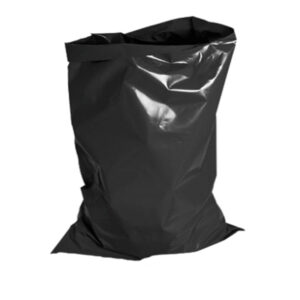Do you get confused when shopping for waste management bags for home or office- Refuse Sacks or Bin Bags? Many people mix up these two kinds of waste bags, but the truth is—they’re not the same!
The good news is that BinBags has the right bag for every waste management job. We offer everything from simple bin bags for home to heavy-duty refuse sacks for commercial facilities.
Let’s make this simple and help you pick the right bag.
What Are Refuse Sacks?
They are made up of Low-Density Polyethylene (LDPE), High-Density Polyethylene (HDPE) and Linear Low-Density Polyethylene (LLDPE).
Sizes and Details
- They can hold 70-160 litres of waste
- Very thick from 80 to 300 gauge,
- Common sizes: 18 x 29 x 34 inches, 20 x 34 x 46 inches
- They are tested to carry 5-30kg of waste
Key Features
- Wide bottom that opens up
- Star-sealed bottom for leak prevention
- UV-resistant options for outdoor use
- Temperature resistance from -40°C to +80°C
What Are Bin Bags?
Refuse sacks are designed for heavy or large volumes of waste collection for industries, but bin bags are thinner and cheaper and suitable for lightweight waste like food scraps and paper.
Types You Can Buy
- Kitchen bin bags (10-50 litres)
- Small bin liners (5-20 litres)
- Medium bin bags (25-50 litres)
- Green bags that break down naturally
- Bags with drawstrings
- Sweet-smelling binbags
You can get binbags in clear, white, green, red or black colours.
Key Differences: Refuse Sacks vs. Bin Bags
1. Strength
Refuse sacks are sturdy and can handle sharp objects, heavy loads and rough handling. They’re thick (20- 50 microns) and won’t tear even under toughest of conditions.
Bin bags are thinner (8- 20 microns) and work fine for normal home waste like food and paper.
2. Size
Refuse sacks have a large capacity (70 to 160 litres). They’re designed for bulk waste collection in commercial places, industrial settings and construction sites.
Binbags are smaller (5 to 50 litres) and fit standard home bins perfectly.
3. Earth-Friendly Options
Modern bin bags are made from natural, plant-based materials that are compostable and break down naturally within 9-18 months.
Black refuse sacks are also available in recycled plastic material. Although they are heavy-duty bags, their main purpose is to provide durability. They are not meant to decompose quickly.They are forever bags.
4. Application
Refuse sacks work best at construction sites, restaurants, hospitals, shopping malls, hospitals and large office buildings. Binbags are perfect for home kitchens, small offices and light cleaning purposes.
Uses Of Refuse Sacks and Bin Bags
Bin bags and refuse sacks bring hygiene to every waste disposal task. They prevent dirt buildup inside bins and limit odour issues. They are available in different colours to make waste sorting easier. Besides waste disposal, these bags can also be used for storage protection, or even materials for craft and DIY projects.
Sizes & Specifications of Refuse Sacks & Bin Bags
Common Sizes
Refuse Sacks:
- Small: 50-100 litres (for office buildings)
- Medium: 100-150 litres (for retail shops & restaurants)
- Large: 150-200 litres (for factories or construction sites)
Bin Bags:
- Small bins: 5-10 liters
- Kitchen bins: 25-50 liters
- Big bins: 120-240 liters
Thickness and Weight
- Light: 8-12 microns (holds up to 5kg)
- Medium: 15-20 microns (holds 5-15kg)
- Heavy: 25-35 microns (holds 15-50kg)
Choosing the Right Option for Your Needs
Pick the waste disposal bag based on what kind of waste you have, their volume, weight and the environment where you’ll use the bags.
- For Your Home: Use light bin bags or biodegradable bin bags for daily kitchen and bathroom waste.
- For Your Office: Black refuse sacks work best for paper waste and office rubbish.
- For Big Businesses: Heavy-duty refuse sacks are needed for construction debris and factory rubbish.
Why Choose BinBags.com for Your Waste Solutions?
BinBags.com has all types of waste disposal bags.
- Variety of Options: We have black refuse sacks, biodegradable bin bags, and heavy-duty bags for any waste handling job.
- Nature-friendly Options: We sell bags that are made from recyclable material and break down naturally.
- Affordable Prices: Buy in bulk for industrial use or a small pack of bin bags for families and save money on refuse sacks and bin bags.
- Quality You Can Trust: All our refuse sacks and bin bags are tested to make sure they work well.
Conclusion
Refuse sacks are sturdy and durable for heavy and large volume waste and are suitable for construction sites and other commercial settings. Binbags are light and suitable for home use. Both bags keep things neat—just match your waste needs to the right type.
Need the right bag for your job? Check out Binbags.com and find your perfect match now!

